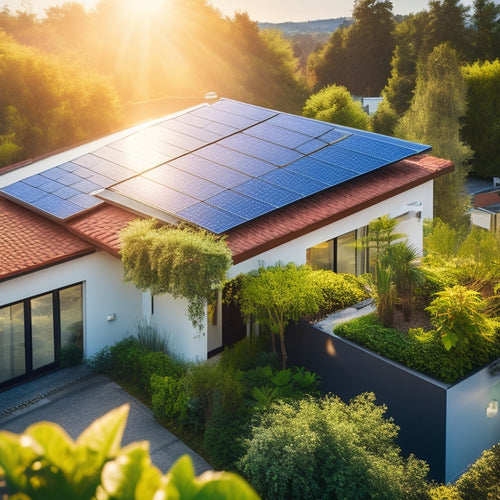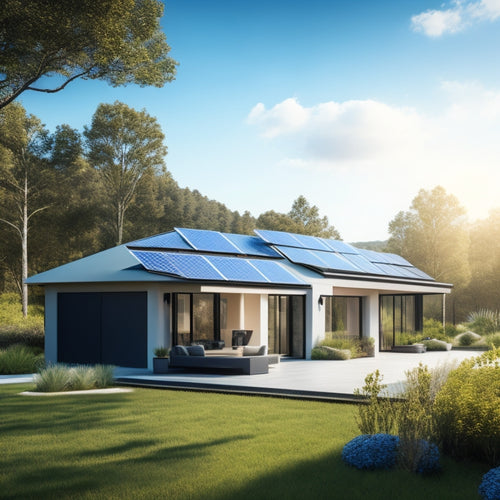
What to Expect During a Residential Solar Panel System Installation?
Share
You can expect an exhaustive process that involves nine distinct stages during a residential solar panel system installation, spanning from preparation and site assessment to installation, quality control, and post-installation support. From securing necessary permits to conducting thorough roof inspections, each stage is critical to ensuring a safe and efficient installation. Throughout the process, you'll work closely with experts to customize your solar panel system, overcome potential challenges, and optimize energy production. As you steer through this expedition, you'll uncover the complexities of solar panel installation, and a clearer understanding of what's involved will emerge.
Key Takeaways
- Investigate financing options, prepare your property, and secure necessary permits before installation to ensure a smooth process.
- A site assessment will evaluate your energy needs, roof condition, and potential obstructions to design an optimal solar panel system.
- The installation process involves site preparation, roof inspection, and setup, followed by quality control and testing to ensure safe and efficient energy generation.
- A final inspection process verifies proper installation, functionality, and compliance with local codes, and system activation involves connection to the grid and performance monitoring.
- Post-installation support includes warranty coverage, maintenance tips, and troubleshooting assistance to ensure reliable system performance and maximize return on investment.
Pre-Installation Preparation Process
Before scheduling a residential solar panel installation, you'll need to prepare your property to guarantee a smooth and successful process. This involves several key steps that will confirm your solar panel system is installed efficiently and effectively.
First, you'll need to investigate financing options to determine how you'll pay for your solar panel system. This may include loans, grants, or other incentives that can help offset the upfront cost.
Once you've secured financing, you'll need to prepare your property for the installation. This may involve trimming trees, repairing your roof, or making other necessary adjustments to guarantee a safe and efficient installation.
Understanding the installation timeline is also vital. Be sure to ask your installer about the expected timeline, including the duration of the installation and any necessary permits or inspections.
Site Assessment and Evaluation
During the site assessment and evaluation, a solar panel professional will visit your property to gather essential information about your energy needs and the feasibility of a solar panel system.
They'll assess your energy consumption patterns, identifying areas of energy inefficiency and opportunities for improvement. This includes analyzing your past energy bills, inspecting your electrical panel, and evaluating your home's energy efficiency.
A thorough solar site assessment will also involve an examination of your roof's size, orientation, and condition to determine its suitability for solar panels.
The professional will check for any obstructions, such as skylights, vents, or chimneys, and assess the amount of shade your roof receives. This information will help them determine the best placement and configuration of your solar panel system.
The energy efficiency evaluation will identify opportunities to reduce your energy consumption, making your home more energy-efficient and increasing the effectiveness of your solar panel system.
System Design and Planning
With a thorough understanding of your energy needs and site assessment, the solar panel professional can now design a customized system that meets your specific requirements. This involves creating a detailed design and plan for your residential solar panel system, factoring in elements such as your energy usage patterns, roof size and orientation, and local building codes.
The design process involves selecting the most suitable solar panel configuration, inverter type, and mounting system to guarantee peak energy efficiency. The professional will also consider design aesthetics, making sure that the system blends seamlessly with your home's structure.
You can expect to receive a detailed design plan, including a system layout, electrical diagram, and energy production estimate.
The goal of this phase is to create a system that not only meets your energy needs but also provides long-term reliability and minimal maintenance. By carefully planning and designing your solar panel system, you can rest easy knowing that you'll be generating clean, renewable energy for years to come.
Permitting and Approvals
The solar panel professional secures necessary permits and approvals from local authorities, ensuring your residential solar panel system complies with all relevant regulations and standards. This involves submitting an application to the local government, which includes detailed system design plans, specifications, and documentation. The application process typically requires a fee, which varies depending on the jurisdiction.
The professional will handle the entire permitting process, ensuring that all local regulations are met. They'll work closely with local authorities to address any concerns or issues that may arise during the review process. This includes obtaining electrical, building, and zoning permits, as well as meeting with local utility companies to obtain approval for grid connection.
Once all necessary permits and approvals are obtained, the installation can proceed. You can expect the permitting process to take several weeks to a few months, depending on the complexity of the application and the workload of the local authorities.
Throughout this process, the solar panel professional will keep you informed of the progress and any additional information required to facilitate a smooth approval process.
Installation and Setup
You're ready to start the installation process, which begins with site preparation work to guarantee a safe and efficient setup.
Next, a thorough roof inspection process will identify any potential issues that need to be addressed before installing the solar panels.
With these essential steps complete, you can move on to system configuration planning, where the specifics of your residential solar panel installation will be finalized.
Site Preparation Work
Preparing your site for solar panel installation is an essential step in the process, requiring attention to detail and a thorough assessment of your property's conditions. This phase involves evaluating your property's layout, identifying potential obstacles, and taking necessary measures to guarantee a smooth installation.
During site preparation, the installation team will perform ground preparation, which includes clearing vegetation, debris, and other obstructions from the area where the solar panels will be installed. This guarantees a stable and level surface for the solar panel system.
Additionally, the team will conduct utility coordination, which involves identifying and marking existing underground utilities, such as electric, gas, and water lines, to prevent damage during the installation process.
The installation team will also assess your property's electrical infrastructure, including the main electrical panel and circuitry, to determine if any upgrades are necessary to support the new solar panel system.
Roof Inspection Process
As your solar panel installation process advances, a thorough roof inspection becomes crucial to guarantee a secure and efficient setup. During this stage, the installation team assesses your roof's condition, searching for signs of wear, damage, or weakness.
They evaluate the structural integrity of your roof, checking for any signs of sagging, rotten wood, or other issues that could compromise the solar panel system's performance or safety.
The inspector examines the roof's age, material, and overall condition, taking note of any defects or vulnerabilities. They check for curled, buckled, or missing shingles, as well as signs of animal or insect infestation.
Additionally, they verify that your roof can support the added weight of the solar panels and their associated equipment.
The inspection team also looks for potential obstructions, such as skylights, vents, or chimneys, that could interfere with the solar panel installation.
They take precise measurements of your roof's dimensions, pitch, and orientation to confirm the solar panels are installed at the best angle for maximum energy production.
System Configuration Planning
With a thorough roof inspection complete, the installation team now focuses on system configuration planning to guarantee a seamless and efficient solar panel installation.
This vital step involves determining the ideal system design, making certain that your residential solar panel system meets your energy needs and complies with local building codes.
During system configuration planning, the installation team will consider various factors, including:
-
Your energy usage patterns: The team will analyze your past energy bills to determine your energy requirements and design a system that meets your needs.
-
Roof size and orientation: The team will assess the size and orientation of your roof to determine the best placement of solar panels.
-
Local solar energy trends: The team will consider local solar energy trends, such as the amount of sunlight your area receives, to guarantee your system is designed for maximum energy production.
- Potential installation challenges: The team will identify potential installation challenges, such as obstructions or shading issues, and develop a plan to overcome them.
Quality Control and Testing
When you've completed the installation and setup of your residential solar panel system, it's essential to conduct thorough quality control and testing to guarantee it's functioning correctly.
You'll need to verify the system's performance by checking its output against the manufacturer's specifications and local building codes. This involves following a final inspection checklist to identify any potential issues or defects that need to be addressed before system commissioning.
System Performance Verification
During the system performance verification process, you guarantee that your residential solar panel installation meets the required standards and operates at peak efficiency.
This critical step confirms your system is producing the maximum amount of clean energy, resulting in significant energy savings.
To verify system performance, the installation team will perform the following tests:
- Electrical testing: Verify that the system is generating electricity safely and efficiently.
- Inspection of connections: Ascertain all electrical connections are secure and meet industry standards.
- Monitoring system setup: Configure the monitoring system to track your energy production and identify potential issues.
- Performance ratio analysis: Compare your system's actual energy production to its expected output to guarantee optimal system efficiency.
Final Inspection Checklist
Your residential solar panel installation is almost complete. Now, it's time for the final inspection, an essential step to guarantee your system meets the required safety protocols and inspection criteria.
The installation team will conduct a thorough examination to verify that all components are properly installed, secured, and functioning as intended. They'll inspect the solar panels, mounting system, electrical connections, and inverters to confirm they're correctly sized, configured, and operating within specified parameters.
The team will also check the system's grounding and bonding, making sure it meets local electrical codes and safety standards. Additionally, they'll verify that all necessary permits and certifications are in place, and that the system is properly labeled and documented.
This inspection is vital to making sure your system operates safely, efficiently, and at peak performance levels. By following a rigorous final inspection checklist, you can be confident that your residential solar panel system is installed correctly and ready to generate clean, reliable power for years to come.
System Activation and Monitoring
Activating your residential solar panel system marks the culmination of a successful installation process.
With the installation complete, it's time to power up and start generating clean energy. System activation involves connecting your solar panel system to the grid and verifying it's operating safely and efficiently.
During activation, your installer will:
- Connect your system to the grid and confirm it's synchronized with the utility company's electrical grid.
- Configure your monitoring tools to track your system's performance and energy production in real-time.
- Perform a series of tests to validate your system is operating within specified safety and performance parameters.
- Provide you with a detailed summary of your system's operation, including how to monitor its performance and troubleshoot any issues that may arise.
With your system activated and monitored, you'll be able to track your energy production, identify opportunities for improvement, and maximize your return on investment.
Post-Installation Support
After your residential solar panel system is up and running, it's essential to have a reliable support system in place to guarantee its peak performance and address any issues that may arise.
You'll want to make certain that your system is properly maintained to maximize its energy output and extend its lifespan. Your installation company should provide you with extensive warranty coverage, including parts and labor, to protect your investment.
Additionally, they should offer maintenance tips and guidance to help you keep your system in top condition. This may include routine cleaning and inspections, as well as troubleshooting assistance to quickly resolve any issues that may arise.
Be sure to ask about their customer support process, including response times and communication channels, to make certain you're comfortable with their level of support.
Frequently Asked Questions
Can I Install Solar Panels on a Metal or Clay Tile Roof?
You can install solar panels on a metal roof, but consider the type of metal and its thickness to guarantee secure attachment. For clay tile roofs, you'll need specialized mounting systems and careful planning to maintain tile integrity and guarantee compatibility.
How Long Does the Solar Panel Warranty Typically Last?
You'll typically get a 25-year warranty on solar panels, covering performance and defects, with some manufacturers offering extended warranty coverage up to 30 years or more, ensuring a lengthy solar panel lifespan and protecting your investment.
Will Solar Panels Affect My Roof's Warranty or Insurance?
As you utilize the sun's energy, you wonder if solar panels will cast a shadow on your roof's warranty or insurance coverage. Rest assured, most roof warranties remain intact, and insurance premiums often stay the same or even decrease with solar panels.
Can I Add More Solar Panels to My System in the Future?
You can easily expand your solar panel system in the future to meet growing energy needs, allowing for seamless solar panel expansion that adapts to your changing lifestyle and energy requirements.
Do Solar Panels Work During a Power Outage?
Think solar panels are a lifesaver during a power outage? Not quite. Without a battery backup, you'll still be in the dark, as solar panels alone can't power your home during an outage, affecting solar panel efficiency - but there are power outage solutions available to change that.
Conclusion
As you near the finish line, remember that "well begun is half done." Your residential solar panel system installation is almost complete, and soon you'll be utilizing the power of the sun to fuel your home. With a thorough pre-installation process, a custom-designed system, and rigorous quality control, you can trust that your solar panel system will be running smoothly and efficiently for years to come. Now, get ready to reap the rewards of your investment and bask in the sunshine of savings!
Related Posts
-

Solar Power Systems for Cost-Effective Sustainability
Investing in solar power systems is a smart move for cost-effective sustainability. You can save about $1,500 annuall...
-

High-Performance Energy-Efficient HVAC Systems
High-performance energy-efficient HVAC systems are essential for reducing energy consumption while improving indoor c...
-

Eco-Friendly Energy Storage Systems for Houses
Eco-friendly energy storage systems for your house let you capture and use renewable energy efficiently. You can choo...


